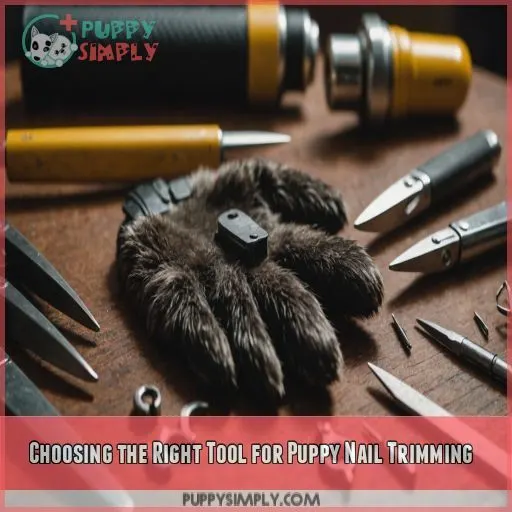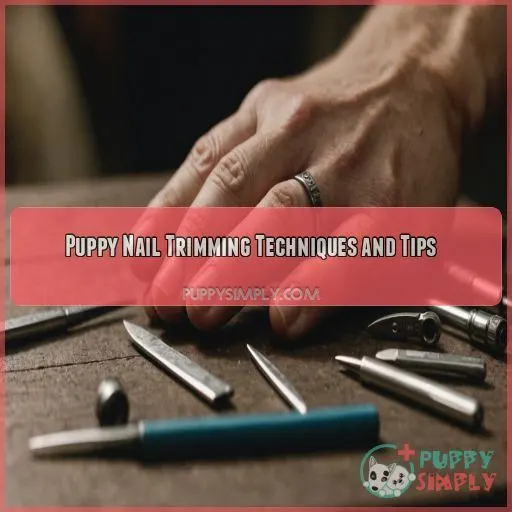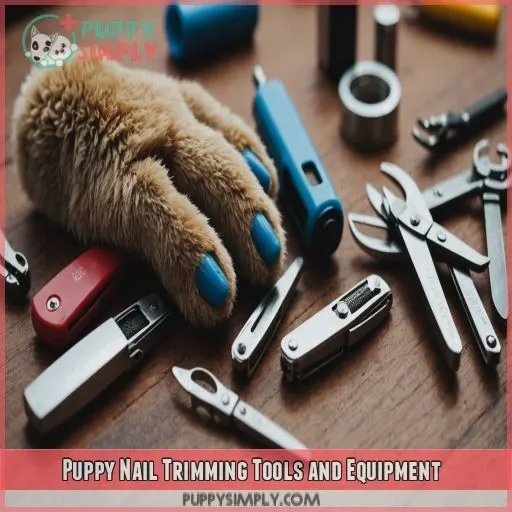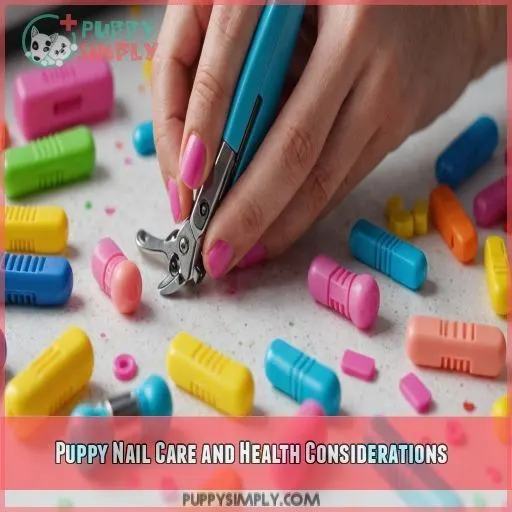This site is supported by our readers. We may earn a commission, at no cost to you, if you purchase through links.
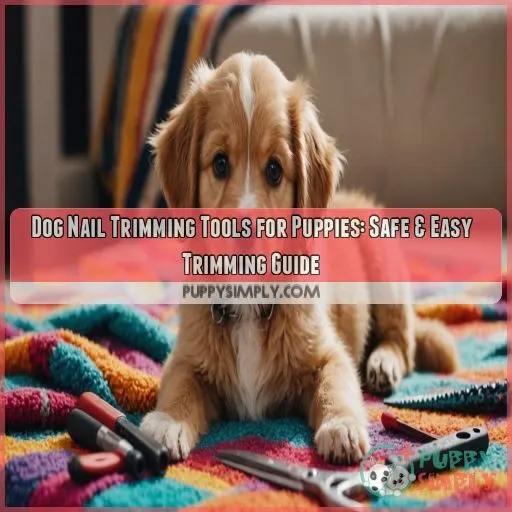 Trimming your puppy’s nails can be a little scary, but with the right tools, you’ll be a pro in no time!
Trimming your puppy’s nails can be a little scary, but with the right tools, you’ll be a pro in no time!
When choosing dog nail trimming tools for puppies, consider their age, nail type, and breed size.
Opt for clippers with a comfortable grip, sharp blades, and a safety guard to prevent cutting the quick.
Grinders are perfect for sensitive pups or those with thick nails.
Ready to learn how to pick the perfect tool and master the art of puppy nail trimming?
Table Of Contents
- Key Takeaways
- Choosing the Right Tool for Puppy Nail Trimming
- Puppy Nail Trimming Techniques and Tips
- Puppy Nail Trimming Tools and Equipment
- Puppy Nail Care and Health Considerations
- Puppy Nail Trimming Age and Frequency
- Frequently Asked Questions (FAQs)
- At what age can you trim a puppy’s nails?
- What can I use to trim my puppy’s nails?
- What nail clipper should I use for my puppy?
- What is the easiest tool to cut dog nails with?
- How do I calm my puppy during nail trimming sessions?
- Can I use human nail clippers on my puppy?
- What are the risks of not trimming my puppys nails?
- How do I know if my puppys nails are too long?
- Can I trim my puppys nails by myself or need help?
- Conclusion
Key Takeaways
- You’re not alone if you’re worried about trimming your puppy’s nails – it’s a daunting task, but with the right tools, you’ll be a pro in no time! Choose a clipper or grinder that fits your puppy’s nail size and type, and don’t forget to prioritize safety features like blade guards and non-slip grips.
- Your puppy’s nail growth rate is like a moving target – it changes as they grow, and you need to adjust your trimming schedule accordingly. Keep an eye out for signs of overgrowth, such as clicking on the floor or visible wear on their paw pads, and trim those nails every 4-6 weeks, or as needed.
- You might be wondering when to start trimming your puppy’s nails – the answer is around 4-6 months old, but it depends on their breed, size, and nail growth rate. Consult with your vet for personalized advice, and remember to start with short sessions and gradually increase the duration as your puppy gets comfortable with the process.
- Don’t even think about using human nail clippers on your puppy – they’re not designed for Canine Nails and can cause pain, injury, or even lead to infection. Get puppy-specific clippers or grinders, and follow safety precautions to avoid injury and make the experience stress-free for both you and your furry friend.
Choosing the Right Tool for Puppy Nail Trimming
You’re getting ready to trim your puppy’s nails, and you want to make sure you’re using the right tool for the job.
With so many options out there, you need to think about a few key factors.
These factors include your puppy’s size, nail type, and your own comfort level with the tool.
This will help ensure the experience is safe and stress-free for both of you.
Factors to Consider for Puppy Nail Trimmers
When choosing puppy nail trimmers, consider your puppy’s age, nail type, and breed size.
Select a clipper size that fits comfortably in your hand and suits your puppy’s nail size.
A good grip is also important to avoid accidents.
Look for puppy nail trimming tools with safety features, such as nail guards or comfortable grips, to make sure the trimming experience is stress-free.
Types of Nail Trimmers for Puppies
Now that you’ve weighed your options, let’s explore the types of nail trimmers for puppies.
You’ve got two main options: clippers and grinders.
Clippers come in various sizes, from small to large, and are suitable for most breeds.
Grinders, on the other hand, are perfect for sensitive pups or those with thick nails.
Choose the best tool for your furry friend!
Safety Features to Look for in Puppy Nail Trimmers
When choosing puppy nail trimmers, prioritize safety features to avoid accidents. Here are three must-haves:
- Blade guards: Prevent cutting the quick and reduce the risk of injury.
- Non-slip grip: Help you keep a firm grip, even with squirmy puppies.
- Adjustable length: Customize the trimmer to your puppy’s nail size for precise cuts.
These features will give you confidence and control when trimming your puppy’s nails at home.
Ease of Use and Comfort for Puppy Owners
Now that you’ve considered safety features, think about your own comfort and ease of use when choosing a puppy nail trimmer.
Look for grips that fit comfortably in your hand, making it easier to maneuver and trim your puppy’s nails.
Comfortable puppy clippers or a nail grinder with a secure hold can make all the difference in a stress-free trimming experience.
Puppy Nail Trimming Techniques and Tips
Now that you’ve got the right tool for the job, it’s time to learn the techniques that’ll make nail trimming a breeze for both you and your puppy.
You’ll learn the essentials of getting your puppy used to nail trimming.
You’ll also learn how to trim safely.
Getting Your Puppy Used to Nail Trimming
Now that you’ve chosen the right tool, it’s time to get your puppy used to nail trimming. Start with early socialization and positive reinforcement to reduce puppy nail trimming anxiety. Gradually introduce the tool, beginning with visual and auditory exposure, then progress to gentle touch and desensitization techniques. Reward calm behavior and make it a fun experience!
How to Trim Your Puppy’s Nails Safely
You’ve got your puppy’s nail trimming tools, now it’s time to get trimming! To trim safely, follow these steps:
- Hold the paw securely: Make sure your puppy’s paw is stable to prevent injury.
- Identify the quick: Locate the pinkish-colored part of the nail to avoid cutting it.
- Trim a little at a time: Take small cuts to avoid cutting too much nail at once.
- Reward good behavior: Praise and treat your puppy for staying calm during trimming.
Avoiding Common Mistakes in Puppy Nail Trimming
When trimming your puppy’s nails, it’s easy to make mistakes. To avoid quick cutting, nail splits, and bleeding, choose the right clipper for your puppy’s nail size and type. Cut just a little at a time, taking breaks to give treats and praise. Keep styptic powder handy to prevent bleeding. Stay calm and patient, and your puppy will too.
Rewarding Good Behavior During Nail Trimming
Reward your puppy with treats, praise, and affection during nail trimming to associate the experience with positive outcomes. Consistency is key, so establish a regular trimming routine. Use clicker training or treat motivation to encourage good behavior. Make it a game or a special bonding time to reduce stress and anxiety.
- Use small, tasty treats to reward calm behavior
- Praise and affection can go a long way in building trust
- Make nail trimming a regular part of your puppy’s grooming routine
Puppy Nail Trimming Tools and Equipment
As you get ready to trim your puppy’s nails, you’ll want to have the right tools on hand to make the experience safe and stress-free for both you and your furry friend. From nail clippers and grinders to styptic powder and nail trimming kits, we’ll explore the must-have equipment you’ll need to keep your puppy’s nails healthy and well-groomed.
Nail Clippers for Puppies
When choosing nail clippers for your puppy, consider their size, nail type, and your comfort level.
Opt for clippers with a comfortable grip, sharp blades, and a safety guard to prevent cutting the quick.
Popular brands like Oster and Andis offer high-quality clippers.
Select the right size and material, such as stainless steel or plastic, for a safe and easy trimming experience.
Nail Grinders for Puppies
If you’re looking for a nail grinder for your puppy, you want a safe and quiet tool that won’t startle them. Look for a grinder with a diamond bit and adjustable speed settings. Unlike clippers, grinders are less likely to cause injury and provide a smoother finish. Consider a cordless grinder for convenience and portability.
Styptic Powder and Other First Aid Essentials
When you’re trimming nails, accidents can happen, and that’s where styptic powder comes in. This miracle worker helps stop bleeding in its tracks. Keep it handy, along with other first aid essentials like bandages and antiseptic wipes. Don’t forget to add a pet nail care first aid guide to your kit for extra peace of mind.
Nail Trimming Kits for Puppies
Now that you’ve got your styptic powder and first aid essentials covered, it’s time to think about a nail trimming kit for your puppy.
You’ll want to look for a kit that includes clippers, a grinder, and other essentials.
Check out puppy nail trimming kit reviews to find the best one for your furry friend.
Consider a DIY kit or an electric dog nail clipper for ease of use.
Puppy Nail Care and Health Considerations
As you care for your new furry friend, you need to prioritize their nail health to prevent painful problems and mobility issues down the line. By understanding the importance of regular nail trimming and recognizing signs of nail health issues, you can help your puppy stay happy, healthy, and active.
Importance of Regular Nail Trimming for Puppies
Regular nail trimming is important for your puppy’s comfort and health. You’ll want to prevent ingrown nails, painful paw pads, and mobility issues. Here are just a few benefits of regular nail trimming:
- Prevents painful paw problems and ingrown nails
- Supports healthy paw pads and joints
- Helps maintain your puppy’s overall comfort and mobility
Signs of Nail Health Issues in Puppies
As you trim your puppy’s nails, keep an eye out for signs of nail health issues. Look for nail splitting, discoloration, or painful nails, which can indicate a problem. If you notice any of these symptoms, consult a vet to rule out nail infections. Regular trimming with the right tools, like stainless steel nail clippers, can help prevent these issues.
How to Prevent Nail Problems in Puppies
Now that you know the signs of nail health issues in puppies, it’s time to prevent them. Establish a regular nail trimming schedule to keep those nails in check. Here are some tips to get you started:
- Trim your puppy’s nails every 4-6 weeks, or as needed, to prevent overgrowth.
- Use a low noise nail grinder or cordless nail grinder for a stress-free experience.
- Keep an eye out for nail splitting and adjust your trimming technique accordingly.
Common Nail Health Issues in Puppies
Now that you know how to prevent nail problems in puppies, let’s talk about common nail health issues.
Overgrown nails can cause discomfort, while ingrown nails can lead to infections.
Nail splitting and discoloration are also common issues.
Regular trimming with a suitable tool, like a heavy-duty nail grinder with variable speed adjustment, can help prevent these problems in your medium-sized dog.
Puppy Nail Trimming Age and Frequency
You’re probably wondering when to start trimming your puppy’s nails and how often to do it – after all, those tiny paws need regular TLC to stay healthy and happy. As your puppy grows, their nail growth rate will change, and you’ll need to adjust your trimming schedule accordingly to prevent overgrowth and related health issues.
When to Start Trimming Your Puppy’s Nails
You’re wondering when to start trimming your puppy’s nails. Generally, it’s around 4-6 months old, but it depends on their breed, size, and nail growth rate. Here are some signs to look out for:
- Your puppy’s nails start clicking on the floor
- You notice their nails are getting too long
- Your vet advises you to start trimming
Consult with your vet for personalized advice.
How Often to Trim Your Puppy’s Nails
Now that you’ve started trimming your puppy’s nails, you’re probably wondering how often to do it.
The frequency depends on your puppy’s age, breed, and lifestyle.
As a general rule, trim your puppy’s nails every 4-6 weeks.
However, if you notice their nails growing too long or too fast, you may need to trim them more often to prevent discomfort and health issues.
Factors Affecting Puppy Nail Growth Rate
Now that you know how often to trim your puppy’s nails, let’s talk about what affects their growth rate. Your puppy’s nail growth rate depends on several factors, including:
- Breed: Larger breeds tend to have faster nail growth
- Diet: A balanced diet rich in nutrients supports healthy nail growth
- Activity level: Puppies who exercise more may need more frequent trimming
- Age and health: As your puppy grows, their nail growth rate may slow down or speed up depending on their overall health
Adjusting Trimming Frequency for Individual Puppies
Now that you know the factors affecting your puppy’s nail growth rate, it’s time to adjust the trimming frequency to their individual needs. Consider their breed, activity level, and nail length to determine the best schedule. Here’s a rough guide to get you started:
| Breed | Activity Level | Trimming Frequency |
|---|---|---|
| Small breeds | Low | Every 4-6 weeks |
| Medium breeds | Medium | Every 6-8 weeks |
| Large breeds | High | Every 8-10 weeks |
| Active breeds | High | Every 6-8 weeks |
| Less active breeds | Low | Every 8-10 weeks |
Frequently Asked Questions (FAQs)
At what age can you trim a puppy’s nails?
Trimming a puppy’s nails is like giving them their first haircut – it requires patience and care. You can start trimming your puppy’s nails as early as 4-6 weeks old, but consult a vet for personalized advice.
What can I use to trim my puppy’s nails?
You can use clippers or grinders specifically designed for puppies, considering their nail size and type. Choose a tool that’s comfortable for both you and your puppy, and don’t forget to follow safety precautions to avoid injury.
What nail clipper should I use for my puppy?
For your puppy, choose a nail clipper that fits their nail size and your comfort level. Consider a clipper with a comfortable grip and sharp blades for a clean, precise cut, making the experience less stressful for both of you.
What is the easiest tool to cut dog nails with?
Imagine wrestling a squid – that’s what cutting dog nails can feel like! But fear not, friend! The easiest tool to cut dog nails with is often a grinder, as it’s less jarring and intimidating for both you and your pup.
How do I calm my puppy during nail trimming sessions?
To calm your puppy during nail trimming sessions, start by gradually introducing the nail trimming tool, rewarding them with treats for good behavior. Be patient, gentle, and go at their pace to avoid overwhelming them.
Can I use human nail clippers on my puppy?
Don’t even think about using human nail clippers on your puppy! They’re not designed for canine nails and can cause pain, injury, or even lead to infections. Get puppy-specific clippers for a safe and stress-free nail trimming experience.
What are the risks of not trimming my puppys nails?
As you cuddle with your puppy, you can’t help but notice those tiny, razor-sharp nails – just waiting to snag your favorite sweater. Untrimmed nails can lead to painful paw pads, mobility issues, and even infections.
How do I know if my puppys nails are too long?
Check your puppy’s nails regularly! If they click on the floor, get tangled in carpets, or start to curl, it’s time for a trim. Look for visible wear on their paw pads or discomfort when walking.
Can I trim my puppys nails by myself or need help?
Practice makes perfect!" Trimming your puppy’s nails yourself is doable, but you need to be cautious and patient. If you’re unsure or uncomfortable, consider consulting a veterinarian or a professional groomer for guidance and support.
Conclusion
You’ve made it through the ultimate guide to dog nail trimming tools for puppies – give yourself a round of applause!
Trimming your puppy’s nails is no longer a scary task, thanks to your newfound knowledge of the perfect tools and techniques.
With the right clippers, grinders, and safety precautions, you’ll be a pro in no time.

